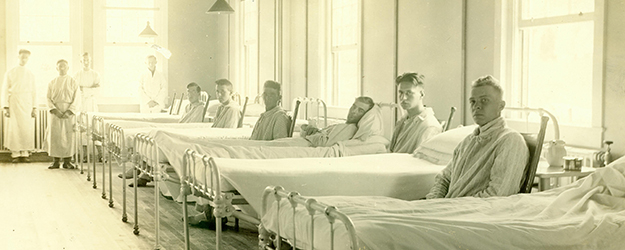Our History

From 1917-1940, the Station Hospital at Aberdeen Proving Ground occupied a variety of temporary and semi- permanent buildings. In 1919, the largest early medical facility with a capacity of 200 beds, was in use at Aberdeen Proving Ground. By 1939, needs were considerably reduced and the hospital was moved to a permanent location with a bed capacity of thirteen.
With a manpower buildup preceding the Nation’s entry into World War II, modernization came to the medical service at Aberdeen proving Ground. With the influx of troops for training, the small facility could not serve the needs of the population. As part of the crash-building plan at Aberdeen Proving Ground in 1941, a 500-bed cantonment hospital was erected in the 2100 block. This remained the MTF at Aberdeen Proving Ground until 1963.
In fiscal year 1960, the Army Medical Department made a move forward in its effort to assure the provision of adequate modern permanent buildings for the hospitalization of patients and the treatment of increasing outpatients loads at Army medical facilities an extensive study resulted in the creation of an entirely new formula for measuring the space requirements of a major Army medical facility. The formula, based on statistical analysis of workloads, staffing requirements, hours of operations, areas required for clinical elements, nursing units, and supportive activities made it possible to predetermine the size of a building required to meet medical needs at a given installation.
As a result of this study, the Army construction program for fiscal year 1961 included an experimental project called Health Activity at Aberdeen Proving Ground, MD. The construction of a 75 bed hospital was begun in July 1961. Kirk Army Hospital, Aberdeen Proving Ground was completed in July 1964. The new facility fulfilled the new concept and design for hospitals in the Army hospital system and revolutionized the building procedure to follow.
Army Maj. Gen. Norman T. Kirk
Kirk U.S. Army Medical Health Clinic is name after Maj. Gen. Norman T. Kirk. Kirk was a much lauded and awarded doctor. His service in World Wars I and II, saved countless lives and his work revolutionized the treatment of amputees. He was awarded the U.S. Legion of Merit, the Distinguished Service Medal, French Legion of Honor, Italian Order of the Crow, Order of the British Empire, and the Swedish Order of the Northern Star during his service and was named Surgeon General of the U.S. Army in 1943.
In 1924, Kirk wrote a standard medical textbook titled
Amputations Operative Technique. In that volume, he spoke on a need to retain as much of a lost limb as possible for better fitting of a prosthetic, an idea still followed almost 100 years later, although revolutionary then. He also recognized that surgeons did not routinely follow their patients through the continuum of care and were often unfamiliar with what factors influenced their patients' outcomes. Kirk had the advantage of continuity of care, and he carefully followed those with limb loss as they arrived from overseas, as well as during the several ensuing months through wound closure, stump healing and initial prosthetic fitting.